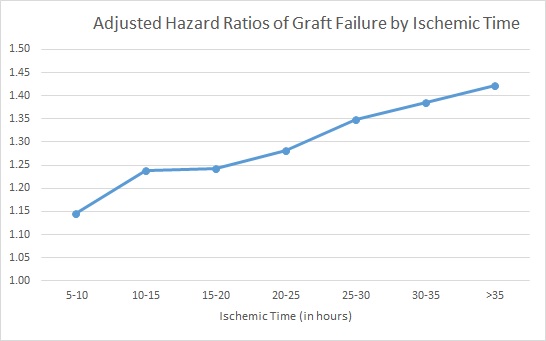Effect of Cold Ischemia Time on Long-Term Graft Survival of Post-One Year Survivor Deceased Donor Kidney Transplant Recipients
1Baylor College of Medicine, Houston, TX, 2University of Texas Medical Branch, Galveston, TX, 3University of Texas Houston Medical School, Houston, TX
Meeting: 2020 American Transplant Congress
Abstract number: C-070
Keywords: Graft survival, Ischemia, Outcome
Session Information
Session Name: Poster Session C: Kidney Complications: Non-Immune Mediated Late Graft Failure
Session Type: Poster Session
Date: Saturday, May 30, 2020
Session Time: 3:15pm-4:00pm
 Presentation Time: 3:30pm-4:00pm
Presentation Time: 3:30pm-4:00pm
Location: Virtual
*Purpose: Prolonged cold ischemia time (CIT) is known to adversely affect short-term graft survival among renal allografts. However, its effect on long-term graft survival is less clear. We evaluated long-term graft survival as a function of CIT for deceased donor kidney recipients who survived one year after transplantation.
*Methods: We analyzed UNOS data from 1/1/1991 to 12/31/2016 and followed until 12/31/2017. Living donor and multi-organ transplants, recipients <18 years age at transplant, and those who died within 1 year of transplant were excluded. Multivariable Cox regression was used to analyze time to graft loss (death-censored) with CIT as independent variable.
*Results: Graft loss (death-censored) was observed in 30,263 of 146,680 (20.8%) recipients during the study period. In univariate analysis, compared with CIT 1-5 hrs, hazard ratio (HR) of graft loss for CIT 5-10 hrs was 1.20, for 10-15 hrs & 15-20 hrs was 1.33, 20-25 hrs was 1.36, 25-30 hrs was 1.43, 30-35 hrs was 1.51, and >35 hrs was 1.59. In multivariate analysis (Tables 1&2), there was a progressive increase in graft loss with increasing CIT such that CIT >35 hrs was associated with 42% higher graft loss (Figure 1). Increased graft loss was also observed in males, Blacks , BMI >30, h/o dialysis prior to transplant, diabetes, PRA >90%, and donor age >50 (HR 1.93). Age >40 yrs at transplantation was associated with lower risk of graft loss (vs 18 to 40 yrs),
*Conclusions: Prolonged CIT adversely affects long-term graft survival among deceased donor kidney recipients. The hazards of graft loss appear to be proportional to the increase in CIT prior to transplantation. Every effort should be made to keep the CIT to the minimum.
| HR | p | ||
| Cold Ischemia (Ref 1-5 hrs) | 5-10 | 1.15 | <0.0001 |
| 10-15 | 1.24 | <0.0001 | |
| 15-20 | 1.24 | <0.0001 | |
| 20-25 | 1.28 | <0.0001 | |
| 25-30 | 1.35 | <0.0001 | |
| 30-35 | 1.39 | <0.0001 | |
| >35 | 1.42 | <0.0001 |
| Age (Ref 18-40 yrs) | 41-51 | 0.65 | <0.0001 |
| 52-60 | 0.53 | <0.0001 | |
| 61+ | 0.46 | <0.0001 | |
| Gender (REf – Female) | Male | 1.08 | <0.0001 |
| Race (Ref – White) | Black | 1.77 | <0.0001 |
| Dialysis (Ref – No) | Yes | 1.41 | <0.0001 |
| Diabetes (Ref – No) | Yes | 1.12 | <0.0001 |
| PRA (Ref 0-79%) | 90-100 | 1.16 | <0.0001 |
To cite this abstract in AMA style:
Murthy B, Nguyen H, Rana A, Awan A, Buren CVan, Goss J. Effect of Cold Ischemia Time on Long-Term Graft Survival of Post-One Year Survivor Deceased Donor Kidney Transplant Recipients [abstract]. Am J Transplant. 2020; 20 (suppl 3). https://atcmeetingabstracts.com/abstract/effect-of-cold-ischemia-time-on-long-term-graft-survival-of-post-one-year-survivor-deceased-donor-kidney-transplant-recipients/. Accessed July 5, 2025.« Back to 2020 American Transplant Congress

